英语中过去分词作定语的语法讲解
- 格式:docx
- 大小:20.12 KB
- 文档页数:2
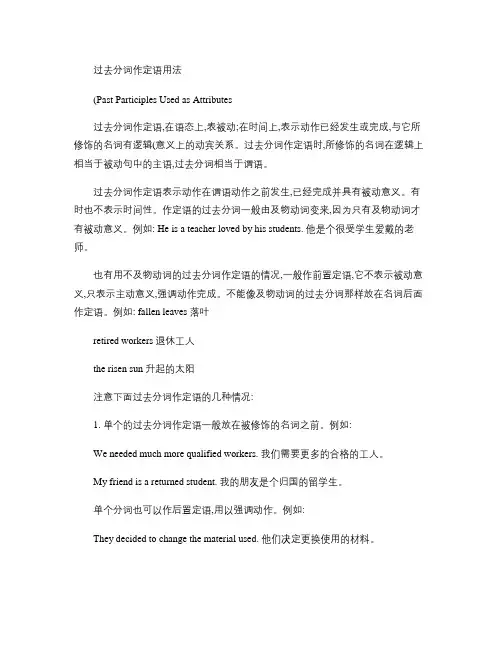
过去分词作定语用法(Past Participles Used as Attributes过去分词作定语,在语态上,表被动;在时间上,表示动作已经发生或完成,与它所修饰的名词有逻辑(意义上的动宾关系。
过去分词作定语时,所修饰的名词在逻辑上相当于被动句中的主语,过去分词相当于谓语。
过去分词作定语表示动作在谓语动作之前发生,已经完成并具有被动意义。
有时也不表示时间性。
作定语的过去分词一般由及物动词变来,因为只有及物动词才有被动意义。
例如: He is a teacher loved by his students. 他是个很受学生爱戴的老师。
也有用不及物动词的过去分词作定语的情况,一般作前置定语,它不表示被动意义,只表示主动意义,强调动作完成。
不能像及物动词的过去分词那样放在名词后面作定语。
例如: fallen leaves 落叶retired workers 退休工人the risen sun 升起的太阳注意下面过去分词作定语的几种情况:1. 单个的过去分词作定语一般放在被修饰的名词之前。
例如:We needed much more qualified workers. 我们需要更多的合格的工人。
My friend is a returned student. 我的朋友是个归国的留学生。
单个分词也可以作后置定语,用以强调动作。
例如:They decided to change the material used. 他们决定更换使用的材料。
2. 过去分词短语作定语要放在被修饰的名词后面,作后置定语,其作用相当于一个定语从句。
例如:The student dressed in white is my daughter.=The student who is dressed in white is my daughter.穿白色衣服的学生是我的女儿。
3. 如果被修饰的词是由every/some/any/no + thing/body/one所构成的复合代词或指示代词those等时,即使一个单一的分词作形容词用,也要放在被修饰词的后面。
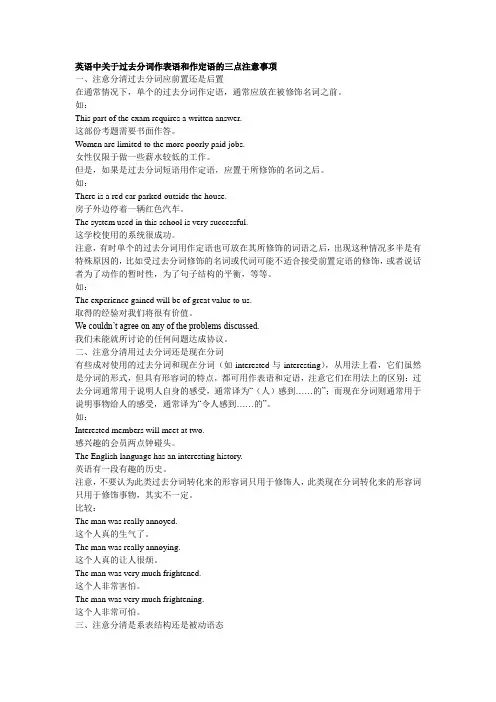
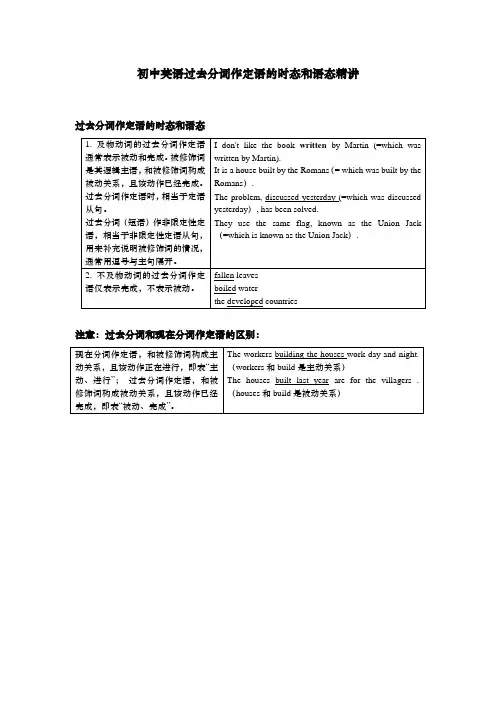

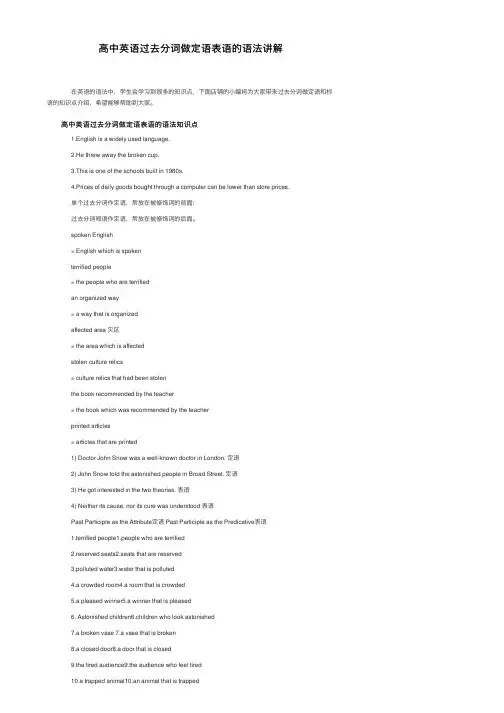
⾼中英语过去分词做定语表语的语法讲解 在英语的语法中,学⽣会学习到很多的知识点,下⾯店铺的⼩编将为⼤家带来过去分词做定语和标语的知识点介绍,希望能够帮助到⼤家。
⾼中英语过去分词做定语表语的语法知识点 1.English is a widely used language. 2.He threw away the broken cup. 3.This is one of the schools built in 1980s. 4.Prices of daily goods bought through a computer can be lower than store prices. 单个过去分词作定语,常放在被修饰词的前⾯; 过去分词短语作定语,常放在被修饰词的后⾯。
spoken English = English which is spoken terrified people = the people who are terrified an organized way = a way that is organized affected area 灾区 = the area which is affected stolen culture relics = culture relics that had been stolen the book recommended by the teacher = the book which was recommended by the teacher printed articles = articles that are printed 1) Doctor John Snow was a well-known doctor in London. 定语 2) John Snow told the astonished people in Broad Street. 定语 3) He got interested in the two theories. 表语 4) Neither its cause, nor its cure was understood 表语 Past Participle as the Attribute定语 Past Participle as the Predicative表语 1.terrified people1.people who are terrified 2.reserved seats2.seats that are reserved 3.polluted water3.water that is polluted 4.a crowded room4.a room that is crowded 5.a pleased winner5.a winner that is pleased 6. Astonished children6.children who look astonished 7.a broken vase 7.a vase that is broken 8.a closed door8.a door that is closed 9.the tired audience9.the audience who feel tired 10.a trapped animal10.an animal that is trapped There are many fallen leaves on the ground. = There are many leaves which had fallen on the ground. (地上有许多落叶) Some of them, born and brought up in rural villages, had never been to Beijing. = Some of them , who had been born and brought up in rural villages, had never been to Beijing. (他们中的⼀些⼈,在农村出⽣并长⼤,从没去过北京) 及物动词的过去分词表⽰结束了的被动动作或者没有⼀定的时间性,只表⽰被动关系。
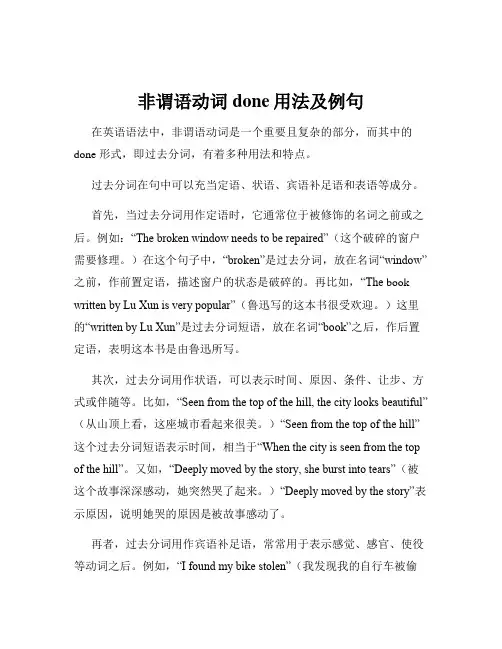
非谓语动词done用法及例句在英语语法中,非谓语动词是一个重要且复杂的部分,而其中的done 形式,即过去分词,有着多种用法和特点。
过去分词在句中可以充当定语、状语、宾语补足语和表语等成分。
首先,当过去分词用作定语时,它通常位于被修饰的名词之前或之后。
例如:“The broken window needs to be repaired”(这个破碎的窗户需要修理。
)在这个句子中,“broken”是过去分词,放在名词“window”之前,作前置定语,描述窗户的状态是破碎的。
再比如,“The book written by Lu Xun is very popular”(鲁迅写的这本书很受欢迎。
)这里的“written by Lu Xun”是过去分词短语,放在名词“book”之后,作后置定语,表明这本书是由鲁迅所写。
其次,过去分词用作状语,可以表示时间、原因、条件、让步、方式或伴随等。
比如,“Seen from the top of the hill, the city looks beautiful”(从山顶上看,这座城市看起来很美。
)“Seen from the top of the hill”这个过去分词短语表示时间,相当于“When the city is seen from the top of the hill”。
又如,“Deeply moved by the story, she burst into tears”(被这个故事深深感动,她突然哭了起来。
)“Deeply moved by the story”表示原因,说明她哭的原因是被故事感动了。
再者,过去分词用作宾语补足语,常常用于表示感觉、感官、使役等动词之后。
例如,“I found my bike stolen”(我发现我的自行车被偷了。
)“stolen”补充说明“bike”的状态,是被偷了。
再看这个句子,“He had his hair cut”(他理发了。
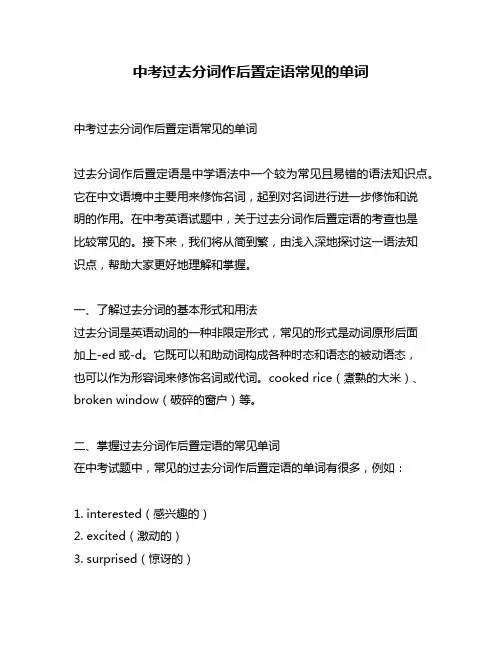
中考过去分词作后置定语常见的单词中考过去分词作后置定语常见的单词过去分词作后置定语是中学语法中一个较为常见且易错的语法知识点。
它在中文语境中主要用来修饰名词,起到对名词进行进一步修饰和说明的作用。
在中考英语试题中,关于过去分词作后置定语的考查也是比较常见的。
接下来,我们将从简到繁,由浅入深地探讨这一语法知识点,帮助大家更好地理解和掌握。
一、了解过去分词的基本形式和用法过去分词是英语动词的一种非限定形式,常见的形式是动词原形后面加上-ed或-d。
它既可以和助动词构成各种时态和语态的被动语态,也可以作为形容词来修饰名词或代词。
cooked rice(煮熟的大米)、broken window(破碎的窗户)等。
二、掌握过去分词作后置定语的常见单词在中考试题中,常见的过去分词作后置定语的单词有很多,例如:1. interested(感兴趣的)2. excited(激动的)3. surprised(惊讶的)4. frightened(受惊的)5. satisfied(满意的)6. bored(厌烦的)7. worried(担心的)8. pleased(高兴的)9. disappointed(失望的)10. amused(觉得好笑的)11. confused(困惑的)12. exhausted(精疲力竭的)以上单词都可以作为过去分词作后置定语,用来修饰各种名词或代词。
通过对这些单词的学习和掌握,可以更好地理解过去分词作后置定语的用法和搭配。
三、总结回顾过去分词作后置定语是中考英语中的一个重要考点,我们在学习和掌握时要注意识记常见的过去分词作后置定语的单词,并在实际的学习和应用中多加练习,以提高对这一语法知识点的理解和运用能力。
个人观点和理解对于过去分词作后置定语这一语法知识点,我认为在学习中要注意区分其形容词和动词的使用,加强对常见单词的记忆和理解,多进行实际运用和练习,以提高语法意识和运用能力。
也要结合实际语境,灵活运用过去分词作后置定语,使语言表达更加准确和地道。
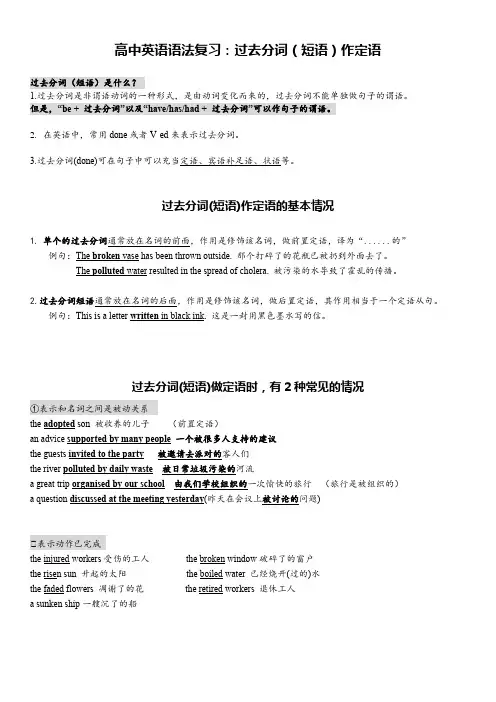
高中英语语法复习:过去分词(短语)作定语过去分词(短语)是什么?1.过去分词是非谓语动词的一种形式,是由动词变化而来的,过去分词不能单独做句子的谓语。
但是,“be + 过去分词”以及“have/has/had + 过去分词”可以作句子的谓语。
2.在英语中,常用done或者V-ed来表示过去分词。
3.过去分词(done)可在句子中可以充当定语、宾语补足语、状语等。
过去分词(短语)作定语的基本情况1.单个的过去分词通常放在名词的前面,作用是修饰该名词,做前置定语,译为“......的”例句:The broken vase has been thrown outside. 那个打碎了的花瓶已被扔到外面去了。
The polluted water resulted in the spread of cholera. 被污染的水导致了霍乱的传播。
2.过去分词短语通常放在名词的后面,作用是修饰该名词,做后置定语,其作用相当于一个定语从句。
例句:This is a letter written in black ink. 这是一封用黑色墨水写的信。
过去分词(短语)做定语时,有2种常见的情况①表示和名词之间是被动关系the adopted son 被收养的儿子(前置定语)an advice supported by many people 一个被很多人支持的建议the guests invited to the party被邀请去派对的客人们the river polluted by daily waste被日常垃圾污染的河流a great trip organised by our school由我们学校组织的一次愉快的旅行(旅行是被组织的)a question discussed at the meeting yesterday(昨天在会议上被讨论的问题)②表示动作已完成the injured workers受伤的工人the broken window破碎了的窗户the risen sun 升起的太阳the boiled water 已经烧开(过的)水the faded flowers 凋谢了的花the retired workers 退休工人a sunken ship一艘沉了的船【过去分词(短语)做定语时的特殊情况】①left,given,concerned,discussed, found, built, invited, mentioned, obtained, received, questioned, shown, told 等是单个的过去分词,但是,通常会放在名词后面作后置定语。
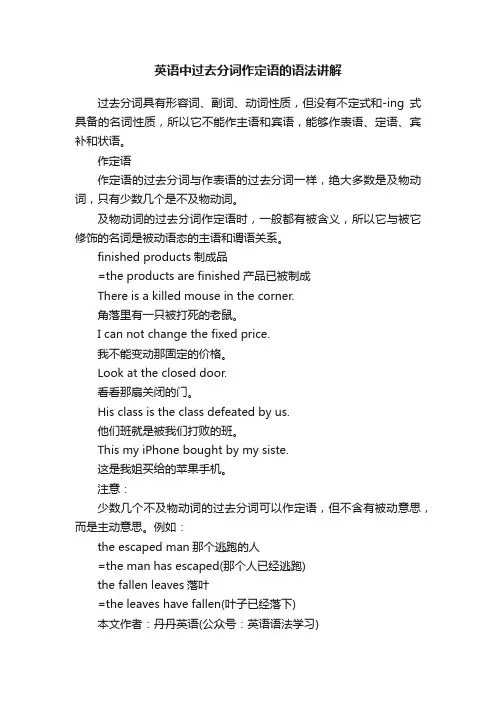
英语中过去分词作定语的语法讲解
过去分词具有形容词、副词、动词性质,但没有不定式和-ing式具备的名词性质,所以它不能作主语和宾语,能够作表语、定语、宾补和状语。
作定语
作定语的过去分词与作表语的过去分词一样,绝大多数是及物动词,只有少数几个是不及物动词。
及物动词的过去分词作定语时,一般都有被含义,所以它与被它修饰的名词是被动语态的主语和谓语关系。
finished products制成品
=the products are finished产品已被制成
There is a killed mouse in the corner.
角落里有一只被打死的老鼠。
I can not change the fixed price.
我不能变动那固定的价格。
Look at the closed door.
看看那扇关闭的门。
His class is the class defeated by us.
他们班就是被我们打败的班。
This my iPhone bought by my siste.
这是我姐买给的苹果手机。
注意:
少数几个不及物动词的过去分词可以作定语,但不含有被动意思,而是主动意思。
例如:
the escaped man那个逃跑的人
=the man has escaped(那个人已经逃跑)
the fallen leaves落叶
=the leaves have fallen(叶子已经落下)
本文作者:丹丹英语(公众号:英语语法学习)。
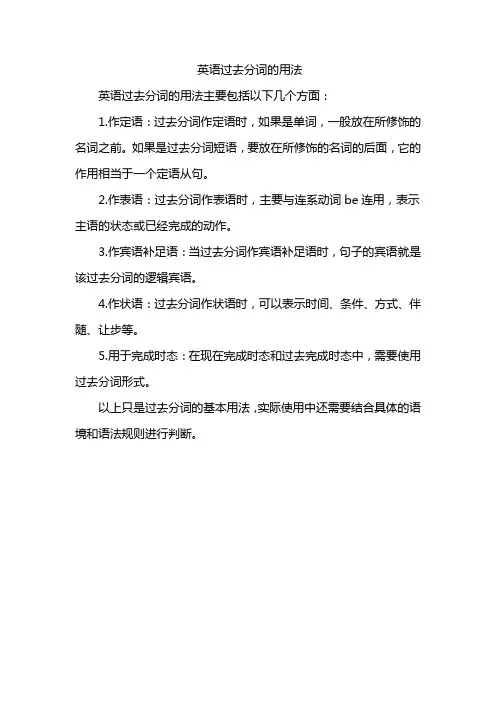
英语过去分词的用法
英语过去分词的用法主要包括以下几个方面:
1.作定语:过去分词作定语时,如果是单词,一般放在所修饰的名词之前。
如果是过去分词短语,要放在所修饰的名词的后面,它的作用相当于一个定语从句。
2.作表语:过去分词作表语时,主要与连系动词be连用,表示主语的状态或已经完成的动作。
3.作宾语补足语:当过去分词作宾语补足语时,句子的宾语就是该过去分词的逻辑宾语。
4.作状语:过去分词作状语时,可以表示时间、条件、方式、伴随、让步等。
5.用于完成时态:在现在完成时态和过去完成时态中,需要使用过去分词形式。
以上只是过去分词的基本用法,实际使用中还需要结合具体的语境和语法规则进行判断。
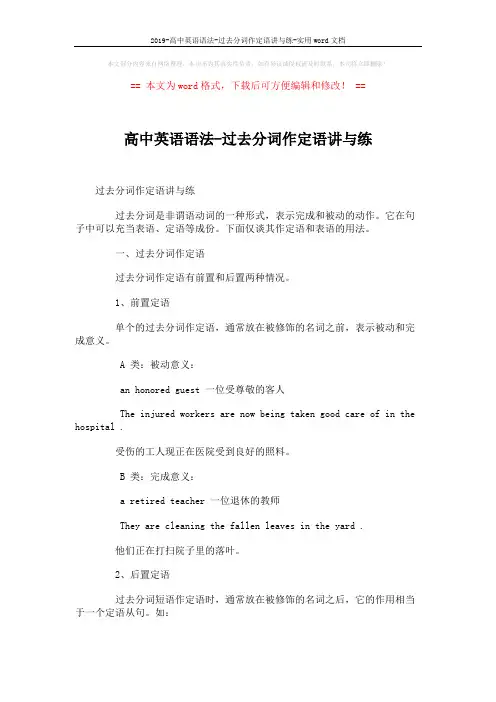
2019-高中英语语法-过去分词作定语讲与练-实用word文档
本文部分内容来自网络整理,本司不为其真实性负责,如有异议或侵权请及时联系,本司将立即删除!
== 本文为word格式,下载后可方便编辑和修改! ==
高中英语语法-过去分词作定语讲与练
过去分词作定语讲与练
过去分词是非谓语动词的一种形式,表示完成和被动的动作。
它在句子中可以充当表语、定语等成份。
下面仅谈其作定语和表语的用法。
一、过去分词作定语
过去分词作定语有前置和后置两种情况。
1、前置定语
单个的过去分词作定语,通常放在被修饰的名词之前,表示被动和完成意义。
A 类:被动意义:
an honored guest 一位受尊敬的客人
The injured workers are now being taken good care of in the hospital .
受伤的工人现正在医院受到良好的照料。
B 类:完成意义:
a retired teacher 一位退休的教师
They are cleaning the fallen leaves in the yard .
他们正在打扫院子里的落叶。
2、后置定语
过去分词短语作定语时,通常放在被修饰的名词之后,它的作用相当于一个定语从句。
如:。
过去分词作定语和状语的用法总结过去分词作定语和状语是英语语法中的两种常用语法形式,用于描述动作和状态。
在过去分词作定语或状语的语法结构中,动词通常使用了-ed或-en的形式,并位于名词或动词后面,用于表示一个已完成的动作或状态。
本文将从以下三个方面对过去分词作定语和状语进行讲解:一、过去分词作定语的用法;二、过去分词作状语的用法;三、过去分词作定语和状语的区别及例句。
一、过去分词作定语的用法过去分词作定语一般位于被修饰的名词之后,用于修饰名词,描述名词所表示的事物的状态或性质,通常用于以下情况:1. 表示被动意义的动作完成态例如:The broken pen cannot be used.(损坏的笔无法使用)The stolen bike has been found.(偷走的自行车已经找到了)2. 表示主动意义的动作完成态例如:The written book was published by a famous publisher.(写作完成的书是由著名出版商出版的)3. 表示状态的形容词例如:The annoyed boss left for a meeting.(心烦意乱的老板去开会了)二、过去分词作状语的用法过去分词作状语一般位于句子中,用于修饰谓语动词,描述动作发生时的情况,通常用于以下情况:1. 表示时间状况例如:He finished his homework, exhausted.(他写完作业后筋疲力尽)She stood there, frozen with fear.(她站在那里,惊恐万分)2. 表示原因或结果例如:Having saved enough money, he bought a new car.(存够了钱,他买了一辆新车)Being late for the meeting, they missed their chance.(因为迟到,他们错过了机会。
)3. 表示条件状况例如:Having finished the task, he went home.(完成任务后,他回家了)三、过去分词作定语和状语的区别及例句过去分词作定语和状语的最大区别在于它们所修饰的词不同。
过去分词作定语是英语语法中的一种特殊用法,它可以给文章带来丰富的表达能力,为文章增加描述性。
首先,过去分词作定语表示完成的动作。
在这种用法中,过去分词作为定语,修饰某个名词,表示在某个时间之前发生的动作已经完成。
例如:The house damaged by the earthquake was demolished.(由地震损坏的房子已经被拆除。
)
其次,过去分词作定语表示正在进行的动作。
在这种用法中,过去分词作为定语,修饰某个名词,表示在某个时间之前正在发生的动作。
例如:The woman walking down the street was my mother.(走在街上的女人是我的母亲。
)
此外,过去分词作定语还可以表示非连续性的动作。
在这种用法中,过去分词作为定语,修饰某个名词,表示在某个时间之前发生的动作,但不一定是持续性的动作。
例如:I saw a man injured in the accident.(我看到一个受了事故伤的人。
)
最后,过去分词作定语还可以表示某一特定的状态。
在这种用法中,过去分词作为定语,修饰某个名词,表示某个时间之前发生的动作,但只表示一个特定的状态。
例如:The food prepared by the chef was delicious.(厨师准备的食物很好吃。
)
总之,过去分词作定语是一种英语语法特殊用法,它可以给文章带来丰富的表达能力,为文章增加描述性。
这种用法可以表示完成的动作、正在进行的动作、非连续性的动作和某一特定的状态。
只要熟练掌握,就可以用这种方式来提升文章的口语表达能力。
过去分词作定语的语法规则过去分词是一种常见的非谓语动词形式,可以用作定语来修饰名词或代词。
在英语语法中,过去分词作定语时需要遵循一些特定的语法规则。
以下是过去分词作定语的几个常见的语法规则:1. 过去分词作定语的位置过去分词作定语通常放在被修饰名词的前面。
例:The broken window needs to be fixed.(需要修理的窗户)2. 过去分词作定语的形式过去分词作定语时,通常要根据被修饰名词的单复数和时态来变化形式。
- 如果被修饰的名词是单数形式,则过去分词要用单数形式。
例:The damaged car is being repaired.(正在修理的汽车)- 如果被修饰的名词是复数形式,则过去分词要用复数形式。
例:The injured players are receiving medical treatment.(正在接受医疗治疗的运动员)- 如果被修饰的名词是过去时态,则过去分词不需要变化形式。
例:The excited children visited the zoo.(兴奋的孩子们参观了动物园)3. 过去分词作定语的语态过去分词作定语时,可以采用被动语态或主动语态。
- 被动语态:表示名词是动作的承受者。
例:The stolen jewelry was recovered by the police.(被盗的珠宝被警方找回)- 主动语态:表示名词是动作的执行者。
例:The excited child showed us her painting.(兴奋的孩子给我们看她的画)以上是过去分词作定语的几个常见的语法规则。
需要注意的是,不同的动词可能有不同的过去分词形式,因此在使用过去分词作定语时,我们需要准确选择正确的过去分词形式来修饰名词。
英语中过去分词作定语的语法讲解
过去分词具有形容词、副词、动词性质,但没有不定式和-ing 式具备的名词性质,所以它不能作主语和宾语,能够作表语、定语、宾补和状语。
作定语
作定语的过去分词与作表语的过去分词一样,绝大多数是及物动词,只有少数几个是不及物动词。
及物动词的过去分词作定语时,一般都有被含义,所以它与被它修饰的名词是被动语态的主语和谓语关系。
finished products制成品
=the products are finished产品已被制成
There is a killed mouse in the corner.
角落里有一只被打死的老鼠。
I can not change the fixed price.
我不能变动那固定的价格。
Look at the closed door.
看看那扇关闭的门。
His class is the class defeated by us.
他们班就是被我们打败的班。
This my iPhone bought by my siste.
这是我姐买给的苹果手机。
注意:
少数几个不及物动词的过去分词可以作定语,但不含有被动意思,而是主动意思。
例如:
the escaped man那个逃跑的人
=the man has escaped(那个人已经逃跑)
the fallen leaves落叶
=the leaves have fallen(叶子已经落下)
本文作者:丹丹英语(公众号:英语语法学习)
本文已获转载授权,版权归作者所有,如需转载,请联系原微信公众号英语语法学习。